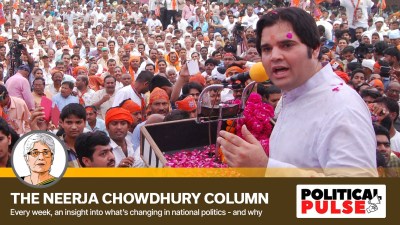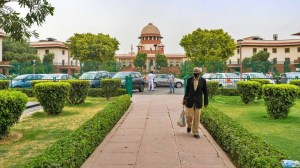- India
- International
Poor dump Left for Trinamool, Muslims solidly behind Didi
Some unhappiness, but no real anti-incumbency; TMC scores high on delivery of social goods
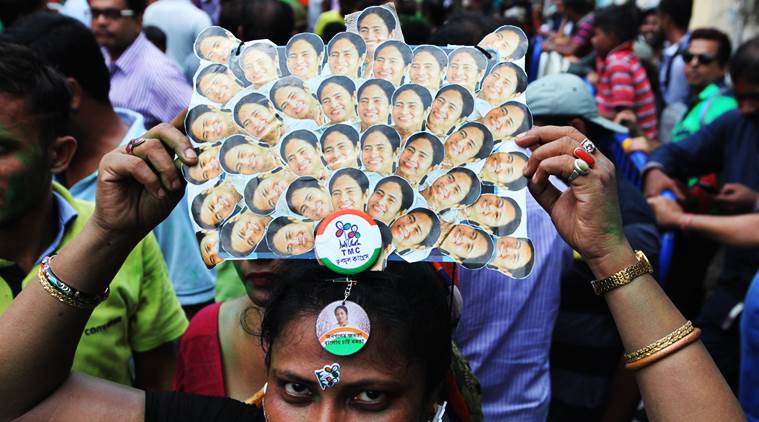 Supporters of TMC outside Mamata Banerjee’s house on May 19, 2016. (Express Photo by Partha Paul)
Supporters of TMC outside Mamata Banerjee’s house on May 19, 2016. (Express Photo by Partha Paul)
If Poriborton — change — was what West Bengal yearned for in 2011, status quo seems to have been the dominant sentiment in 2016. Having ended the 34-year rule of the Left just five years ago, it was perhaps too early for voters to bring it back to power. While respondents in Lokniti’s post-poll survey did not rate the performance of the TMC government all that highly (the ratio of complete satisfaction versus complete dissatisfaction was 24:20, see Table), in direct comparison with the previous government, it was seen by most voters as being better, 38% to 28%.
Read | West Bengal: Left-Congress alliance weak in arithmetic and chemistry
 On almost all issues of governance — roads, electricity and drinking water, quality of education and health services etc. — most voters, including BJP voters, thought that things had improved as compared to 2011, when the Left went out of office. For instance, 59% of voters said the condition of roads had improved; this figure was quite high at 47% even among BJP voters.
On almost all issues of governance — roads, electricity and drinking water, quality of education and health services etc. — most voters, including BJP voters, thought that things had improved as compared to 2011, when the Left went out of office. For instance, 59% of voters said the condition of roads had improved; this figure was quite high at 47% even among BJP voters.
Read | Corruption an issue in West Bengal, but development No. 1
Thus, in spite of a negative assessment on some issues, a concrete urge to replace the government did not exist, nor did an alternative exist. The survey also found the sentiment of pro-incumbency vis-à-vis anti-incumbency (those who said they wanted the government to continue as against those who wanted it to change) to be 43:35. This ratio is much better than the one (38:46) recorded in 2011 against the Left Front government. Thus, there was not enough political space for another round of ‘poriborton’.
Welfare schemes delivered

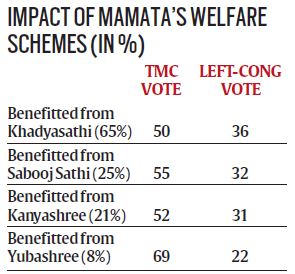 Much credit for the TMC’s victory goes to three welfare schemes: Khadyasathi (rice and wheat at Rs 2/kg), Sabooj Sathi (free bicycles for schoolchildren) and Kanyashree. The survey found over two-thirds of voters had benefitted from the Khadyasathi scheme launched only earlier this year, and half of them voted for the TMC.
Much credit for the TMC’s victory goes to three welfare schemes: Khadyasathi (rice and wheat at Rs 2/kg), Sabooj Sathi (free bicycles for schoolchildren) and Kanyashree. The survey found over two-thirds of voters had benefitted from the Khadyasathi scheme launched only earlier this year, and half of them voted for the TMC.
Read | Historic sweep powered by Mamata
A fourth of voters said that a schoolgoing child in their homes had received a free bicycle under the Sabooj Sathi scheme started last year, and 55% of such voters voted for the Trinamool Congress.
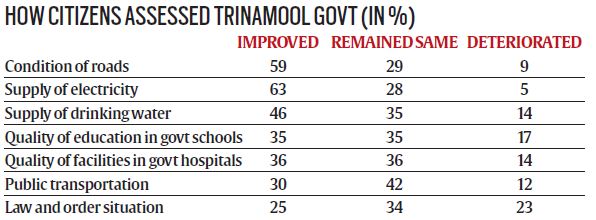 Twenty-one per cent said their households had benefitted from the Kanyashree scheme (launched in 2013 for the empowerment of the girl child), and the TMC’s vote share among them was 52%. As far as the Yubashree scheme (financial assistance to unemployed youth) is concerned, only 8% of voters said their households had benefitted; however the TMC’s vote share among them was a staggering 69%.
Twenty-one per cent said their households had benefitted from the Kanyashree scheme (launched in 2013 for the empowerment of the girl child), and the TMC’s vote share among them was 52%. As far as the Yubashree scheme (financial assistance to unemployed youth) is concerned, only 8% of voters said their households had benefitted; however the TMC’s vote share among them was a staggering 69%.
Poor and Muslims, the twin pillars of success
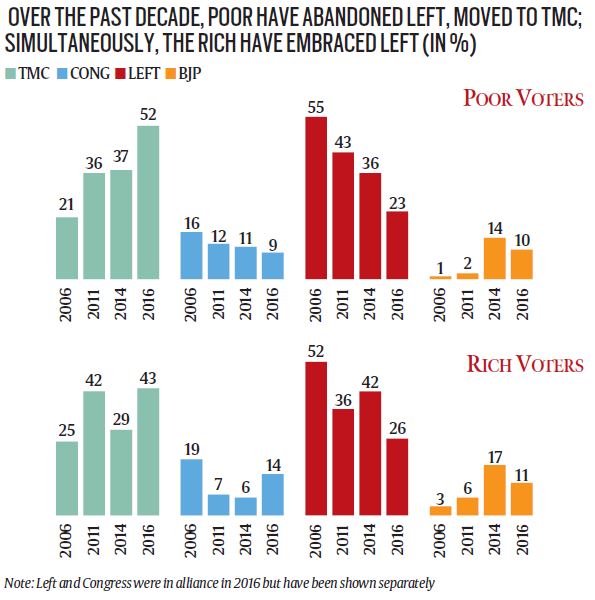 The TMC’s support among the poor is stronger than ever. Fifty-two per cent of poor voters supported the party in these elections, up from 36% in the 2011 Assembly elections. The gains came largely at the expense of the Left, whose vote share among the poor fell from 43% in 2011 to 23%. And in a reversal of voting patterns from 2011, the Left performed more strongly among the rich and the middle class than the poor and lower classes.
The TMC’s support among the poor is stronger than ever. Fifty-two per cent of poor voters supported the party in these elections, up from 36% in the 2011 Assembly elections. The gains came largely at the expense of the Left, whose vote share among the poor fell from 43% in 2011 to 23%. And in a reversal of voting patterns from 2011, the Left performed more strongly among the rich and the middle class than the poor and lower classes.
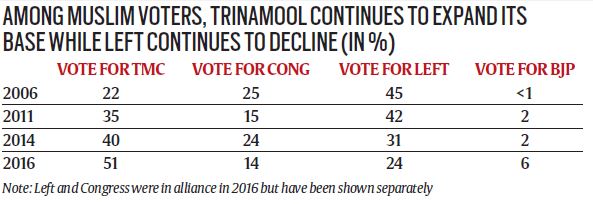 TMC’s success among poor voters is in large part due to shifts in the voting patterns of Muslims. After Jammu & Kashmir and Assam, West Bengal is the state with the largest share of Muslim population (27%). Muslim voters were essential to the success of the Left-Congress. But the survey data show that more Muslim voters have left the Left Front for the TMC since 2011, even as the Congress has made few gains. The Left’s support among Muslim voters, after sliding from 45% in 2006 to 42% in 2011, tumbled to 24% in these elections. After declining from 25% of Muslim voters in 2006 to 15% in 2011, the Congress won 14% of Muslim voters in 2016. The TMC, which expanded its vote share among Muslims from 22% in 2006 to 35% in 2011, for the first time won a majority of Muslim voters (51%).
TMC’s success among poor voters is in large part due to shifts in the voting patterns of Muslims. After Jammu & Kashmir and Assam, West Bengal is the state with the largest share of Muslim population (27%). Muslim voters were essential to the success of the Left-Congress. But the survey data show that more Muslim voters have left the Left Front for the TMC since 2011, even as the Congress has made few gains. The Left’s support among Muslim voters, after sliding from 45% in 2006 to 42% in 2011, tumbled to 24% in these elections. After declining from 25% of Muslim voters in 2006 to 15% in 2011, the Congress won 14% of Muslim voters in 2016. The TMC, which expanded its vote share among Muslims from 22% in 2006 to 35% in 2011, for the first time won a majority of Muslim voters (51%).

EXPRESS OPINION
Apr 25: Latest News
- 01
- 02
- 03
- 04
- 05











